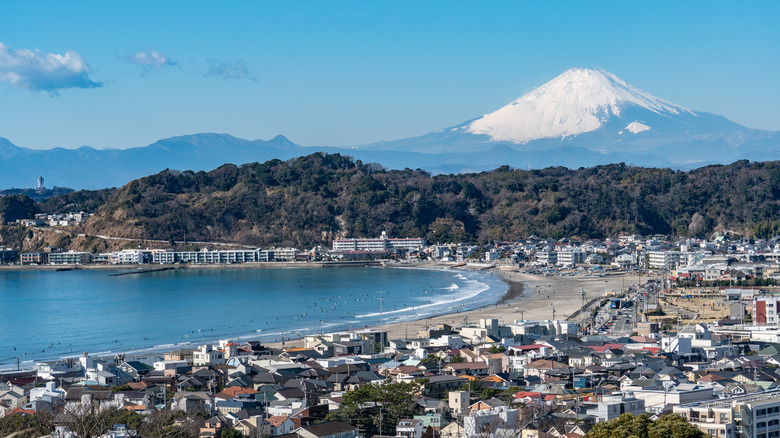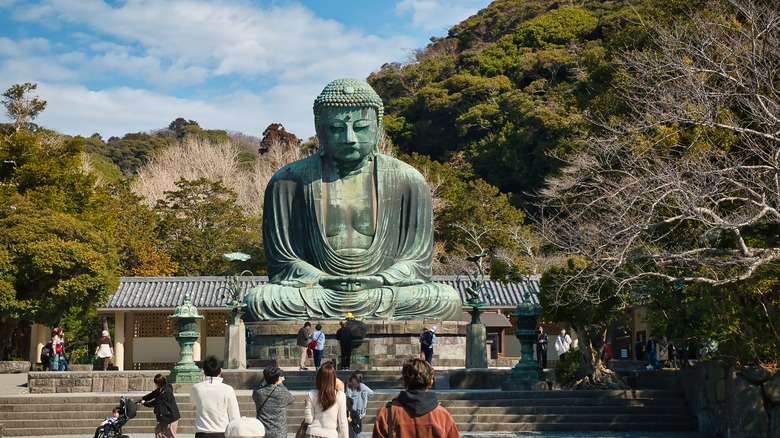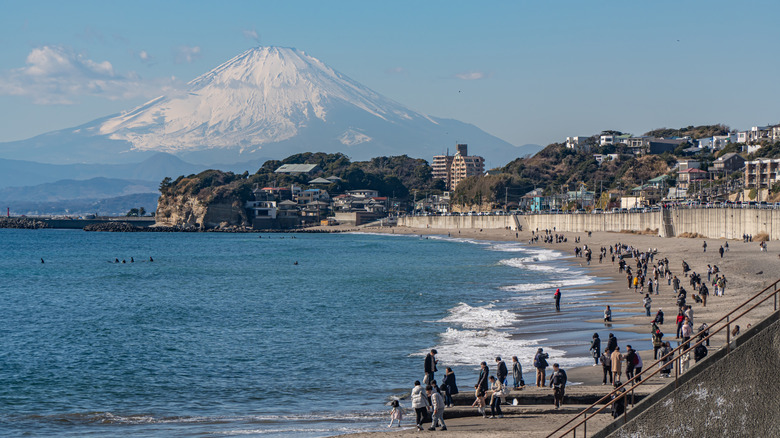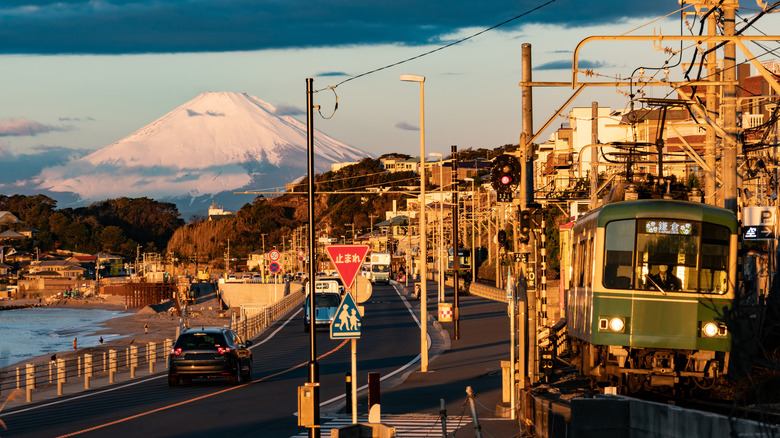Japan's Ancient Capital City Brims With Lush Trails, Serene Beach Resorts, And Glittering Temples
Often called the Land of the Rising Sun, the historic cities of Japan have always been a draw for tourists. Tokyo is an obvious choice, but beyond the capital city, which is often expensive, Japan is filled with stunning destinations that won't break the bank. Kyoto and Osaka are popular alternatives, but one slightly smaller town in Kanagawa Prefecture just an hour south of Tokyo is often overlooked by travelers to these shores. Long before Tokyo became the bustling metropolis we know today, Kamakura was the seat of Japan's feudal power. Steeped in centuries of culture, earning it the nickname "Little Kyoto," Kamakura's ancient streets hide a fun, modern charm and should definitely be added to your Japan itinerary.
Kamakura's history begins in the late 12th century, when a nobleman from a powerful samurai clan, Minamoto no Yoritomo, seized control of Japan from the Emperor and established himself as the first shogun, or military leader. Yoritomo declared Kamakura as the country's new capital, and the next 150 years were thus known as the Kamakura period, an era when much of Japan's traditional culture took shape. Dozens of beautiful temples and shrines were built to ensure the prosperity of the newly emerging samurai clans, many of which can still be seen today.
Surrounded by verdant mountains, the gentle slopes are crisscrossed by scenic hiking trails with sweeping views of Kamakura below, many of them connecting various temples together. Surfers are also drawn to the waves along Kamakura's coastline, where beachgoers looking for a sunny getaway can book a stay in one of the many luxury resorts. And while you might think a trip to Japan is beyond your budget, because of the weak currency, at the time of writing, it's one of the best destinations where the US dollar goes furthest.
What to see and do around Kamakura
A trip to Kamakura isn't complete without a visit to see the Great Buddha, an impressive bronze statue meditating serenely atop a stone pedestal within Kotokuin Temple. Constructed in the 13th century, it's one of the most recognizable landmarks in Kamakura. To really appreciate the Great Buddha's sheer size, you can pay an extra few cents on top of your temple entrance ticket (which only costs about a dollar) to step within the bronze statue and see it towering above you from the inside. Another temple you shouldn't miss is Engaku-ji, a Zen Buddhist monastery founded in the 13th century, famous for its stunning two-tiered wooden entrance gate. The temple grounds, set against Kamakura's mountain slopes, are particularly breathtaking when the surrounding maple trees turn orange in the autumn. Take some time to admire the architecturally stunning buildings before stopping at the temple's teahouse for a bite of some traditional Japanese sweets and a cup of tea.
As it's a popular tourist spot, you may eventually find yourself at the Komachi-dori, a seemingly endless pedestrians-only avenue lined with adorable cafés, gift shops, and restaurants serving Kamakura's local delicacy, whitebait fish. Wasai Yakura is one such eatery with a rustic, Japanese-style atmosphere, popular not just with tourists but locals too. The seafood here is caught fresh daily, and you can enjoy a variety of authentic dishes, from rice bowls topped with whitebait and bluefin tuna to raw sea urchin and local vegetables. Along Komachi-dori, you'll also find plenty of stalls selling crowd-pleasing street foods like shrimp dumpling skewers, strawberry rice cakes, and waffles filled with blueberry cream cheese in the shape of Kamakura's Great Buddha. Just remember not to eat while walking to avoid the side-eye from locals for breaking this unexpected custom.
Beaches and outdoor adventures in Kamakura
Aside from centuries-old temples and shrines, Kamakura is dotted with sandy shorelines that regularly draw surfers trying to catch a few waves. Just a 20-minute walk from Kamakura's main train station is Yuigahama Beach, which flourishes during the summer months with seafront cafés, beach huts, and Hawaiian-themed shops, a tropical contrast to the city's traditional architecture. Townies from Tokyo flock here regularly, trading the oppressive city heat for stunning turquoise waters and fresh air. Yuigahama Beach is only a 15-minute walk from the Great Buddha statue, so you could combine an early morning visit to a cultural landmark with an afternoon bronzing yourself under the sun.
For family fun, Zaimokuza Beach is another popular alternative. The shallow seawater here is ideal for young children to splash and play, with lifejackets available for rent. Surfboards, kayaks, and paddleboard rentals are also readily available here. Perhaps the most stunning aspect of Zaimokuza Beach is that, due to its southwesterly direction, you can see the snowy slopes of Mount Fuji rising up behind the craggy cliffs along the bay on clear days. Zaimokuza Beach and Yuigahama Beach are within 10 minutes' walking distance of each other, so if you're pressed for time, you could visit both in one day.
Hike some of Kamakura's gorgeous nature trails for an outdoor experience that doesn't involve crashing waves. Beginners might enjoy the Daibutsu Hiking Course, which starts near the Great Buddha and traverses wooded hills with occasional vistas of the seashore. A more challenging option is the Tenen Hiking Trail, a steep trek through serene trees and rocky cliffs. This trail begins at Kencho-ji, a sprawling Zen temple complex, and upon reaching the end, you'll find the peaceful Zuisen-ji Temple, a spiritual reward worthy of an energetic hike.
Planning a trip to Kamakura
To get to Kamakura, you'll need to fly into Tokyo, either at Narita or Haneda Airport. From Narita, take the 90-minute Narita Express train (NEX) to Tokyo Station, where you can get the JR Yokosuka Line train straight to Kamakura Station in under an hour. One-way tickets for the Narita Express cost roughly $30 at the time of writing. From Haneda, take the Tokyo Monorail to Hamamatsucho Station, then switch to the JR Yamanote Line for Tokyo Station. If you're going to explore Tokyo first, you can also get to Kamakura from Shinjuku Station. Take the JR Shonan Shinjuku Line train headed towards Zushi for a direct journey to Kamakura.
Day trips to Kamakura are certainly manageable, but definitely consider spending at least one night to fully absorb the sights and attractions. Accommodation ranges from traditional Japanese-style guesthouses to all-inclusive resorts. The Malibu Hotel is a great option; just a 20-minute walk to Zaimokuza Beach, with dog-friendly guest rooms, fantastic cuisine, and a luxurious spa. Another choice is the Tosei Hotel Cocone, designed in a stunning traditional wooden style and also includes public hot spring bath facilities, only about a 10-minute walk to Yuigahama Beach.
The best time to visit for a seaside getaway is during July and August, when the seafront shops and restaurants are open for business. If you're there to appreciate the cultural landmarks, the spring months of March and April are particularly magical with cherry blossoms in full bloom, while the later months from September until November are perfect for seeing Kamakura's temples and nature trails bursting with autumn colors. Winter can also be fun, as there are bustling Christmas markets in December. Whenever you choose to visit, Kamakura is a fantastic town where ancient history meets modernity.



